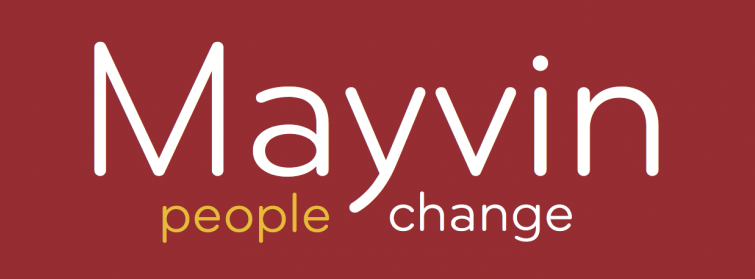Using language that feels real to the client helps to ground our work as Organisation Development & Design practitioners. Clear communication helps create successful, lasting change. At Mayvin we have been exploring what two different worlds - sign language and arts interpretation - can teach us about how to talk the real language of organisations.
Last year we invited two guest speakers, Sandi Drewett (Director of Workforce and Organisational Development at Moorfields Eye Hospital NHS Foundation Trust) and Sophie Shaw (arts interpretation and narrative development specialist) to help us see the language of OD & D through a different lens. Sandi and Sophie shared their experiences from the worlds of sign language and curatorial practice. Together with the Mayvin Community, we inquired into how principles from these different fields of expertise could help us better communicate the work of OD & D to create powerful change.
We run a regular programme of events and if you are interested, you can find out about our future events here: Mayvin Events Calendar.
In this blog, Sandi and Sophie share the principles they have developed to keep clear and grounded:
Sandi Drewett: What happens when you try to translate the language of OD into sign language?
Sign language is my mother tongue, the language of OD is one that I have learned. I wondered what would happen if I tried to translate the language of OD into sign language. What would it teach me about how we make Organisation Development and Design real and accessible without dumbing it down for the clients we serve?
Sophie Shaw is an artist, teacher, curator and nothing to do with the OD world. In her work in museums and curation, Sophie found that the more specialist the subject matter she was working with was, the more the experts wanted to compromise on the messages they gave to their visitors. She developed a commitment to the radical idea that no idea is too complex to be communicated simply in a way which people can take on and share.
Together, Sophie and I tried to develop some thinking to share about applying our knowledge and experiences from other fields to OD. Our offer to the wider community was how to be more direct and compelling in articulating what we do.
Sign language is about direct communication. It developed and grew from a real need for deaf people to be able to communicate with each other and across the deaf/ hearing boundary. It takes the place of aural language: there are no known hearing communities that have developed sign language as replacement for spoken language. It is a complete language with rules, grammar and syntax. Although it has a smaller lexicon than spoken English it has greater flexibility, not everything is translatable from English into sign and vice versa.
Here's what I've learnt:
Start somewhere you know and make sure you know it. If you aren’t fully conversant with your subject matter then it’s harder to make it real for your audience
Telling the story is easier than explaining the theory. It is easier to translate things when focusing on what connects us, the common experiences we share together. In the same way, the best OD work connects us with ourselves and to each other whilst building on an almost ‘hidden’ framework of theory and applied behavioural science.
Clarity and directness are key. Sign language is clear and direct. It can describe as well as name. In OD we frequently name things and assume that others know what we are talking about. How could we get better at describing what we mean? Sometimes you have to break something down into the component parts to be able to build it back up as a concept. There are deliberate choices to be made about how you break it down in translation.
Adjacency aids understanding. In sign language, there are some signs that are close to each other in location or handshape so meaning can be inferred through adjacency. In OD, think about what is adjacent to what that could help you drive understanding and comprehension?
Fingerspelling. The opportunity to directly translate comes through fingerspelling - when we can literally spell out each word letter by letter. However this is predicated on the receiver understanding the word you are spelling out. Fingerspelling is also used to clarify signs that are not understood by the receiver. In OD we sometimes assume that the other person knows what we are saying. What is our fallback position if someone doesn't understand? And how do we know if they don't?
Repetition. In OD we have many terms that are very similar ways of nuancing different concepts. When I attempted to translate these into sign, I found that there are repetitive themes. A bullet point list of how to define OD can be translated down to just a couple of dynamic signs: systems, people, patterns and connections which have the ability to be put together in myriad different ways.
Who is your audience? You can’t sign and speak English at the same time as the structure and grammatical form is very different. There is an art in translation: in choosing signs and tailoring these to the audience that you are translating for. Likewise in OD there is a choice to be made in how we choose the language we use for the audience we use it for. With other practitioners we may use specific terms and phrases that are effectively ‘short cuts’ in the community, examples include ‘self as instrument’ and ‘systems thinking’.
Sophie Shaw: What can we learn from art exhibition interpretation – specifically object label writing - when presenting specialist ideas for non-specialist audiences?
I started out in interpretation for art exhibitions. I got into this through academic art history via exhibition curation. Now I work across art forms, in the heritage sector and more recently in the tech sector. I’m also now an accredited relational dynamics coach, which has added new layers to how I think about communication and change and the relationship between the two.
At its heart what I do is to find ways of communicating specialist, sometimes complex knowledge or ideas to a general audience. I did an MA in art history and I noticed that the more I got into the academic conceptual ideas about art, the harder it was to talk to people about art – by people I mean literally anyone who hadn’t been on that specific course and I found this really frustrating – like I had new toys and I wasn’t able to share them.
Talking with Sandi, we realised that this experience is familiar to OD practitioners too. It's exciting to talk OD with other practitioners. But when it comes to connecting with the wider organisation, the OD language used - often abstracted and theoretical - can appear disconnected from the organisational reality, which is frustrating for organisations and practitioners alike.
Here are the key principles I use in my practice that could be adopted for OD & D:
There is no idea too complex to be included in an object label. Often, people understand the need to be intelligible to a general audience as a call to dumb down their ideas. It doesn’t need to be this way.
Putting things simply is not about being simplistic. It's about using plain English (for example) and building simple sentences which make it easy for people to take in information. It is not about limiting your ambitions for what these simple sentences can contain.
Use building blocks. If you are introducing a complex term or idea, provide the building blocks - the component ideas - that people will need to take this in before you name it.
Don’t assume your audience comes with any specialist knowledge, but don’t patronise them. The old adage of speak to others as you would like to be spoken to applies here as much as anywhere, and doing either of the above will result in your audience disengaging.
It's about your reader, not you. Think about what the reader needs to know in order to get something from what you’re presenting first, rather than what you are most excited about telling them.
Stick to the word limit. When talking about a subject we’re interested in or have specialist knowledge of, there will always be more we want to say. Word limits help us stay on the right side of the ‘it's about the reader’ line.
Do the hard work. All of the above requires putting a lot of thought into how you communicate. Basically, as the interpretation for a museum exhibit, you are putting in as much of the hard work as you can so that your audience can channel their work into taking in new information.
We offer these insights in the hope they may usefully inform and shape your OD practice. This is an ongoing inquiry for us: in this blog we have presented the theoretical ideas which came up as we explored these avenues, and which we shared as part of the event last year. We also presented opportunities to connect these ideas with more immediate, emotional aspects of this subject. In our next blog, we'll be sharing this experiential aspect of the event and inviting you to explore these concepts first hand.

